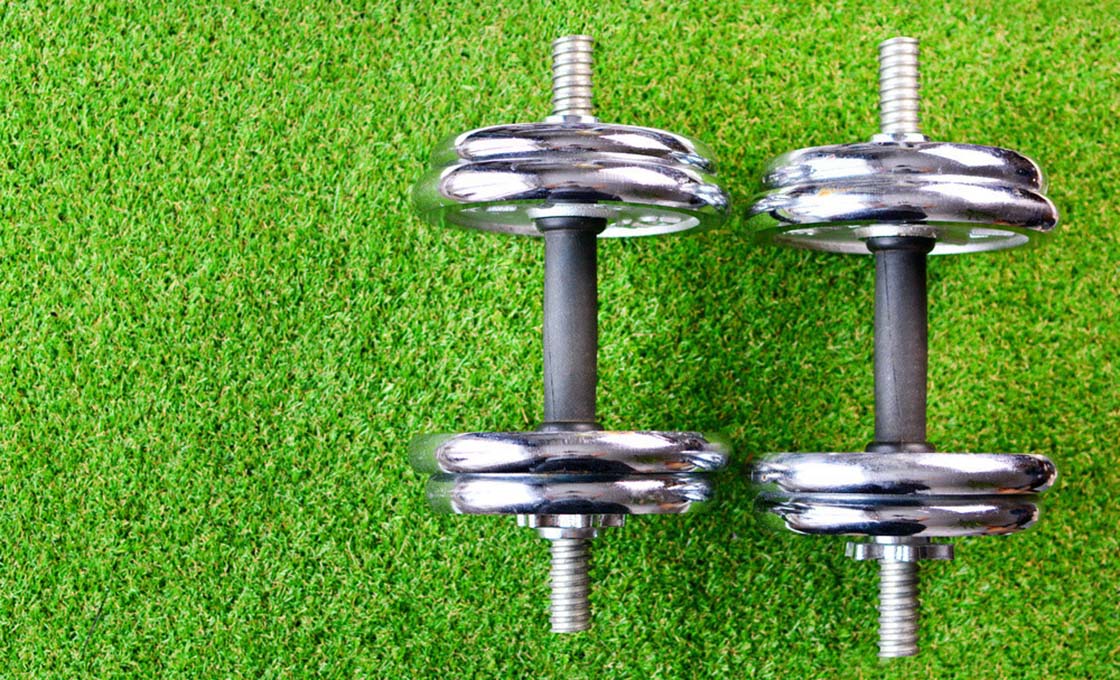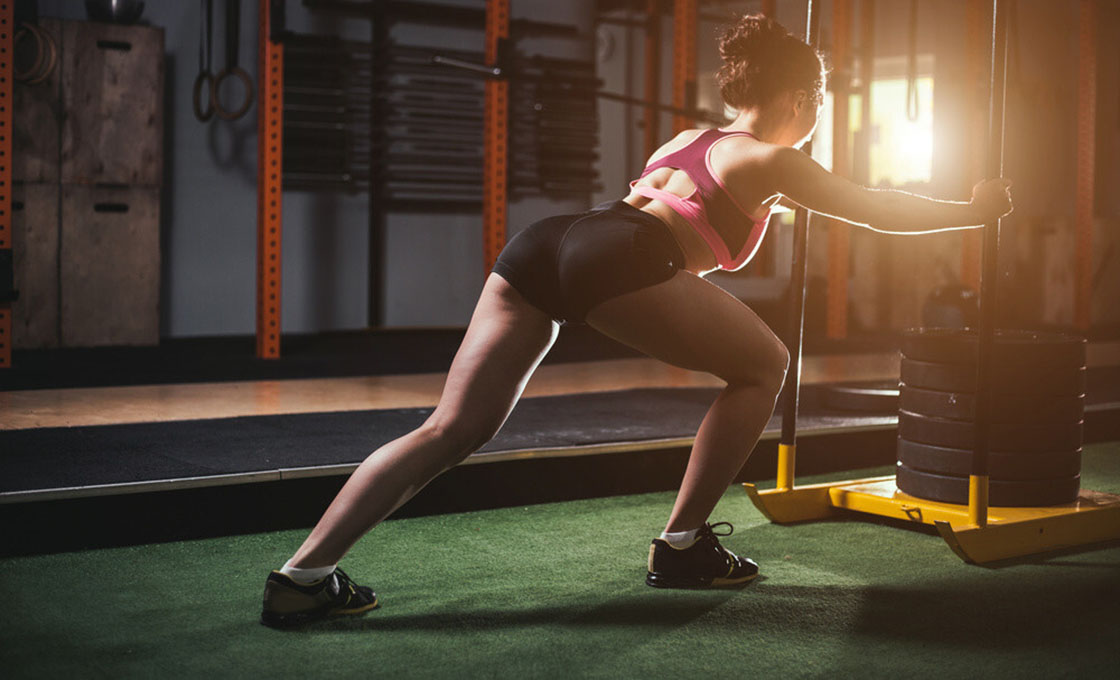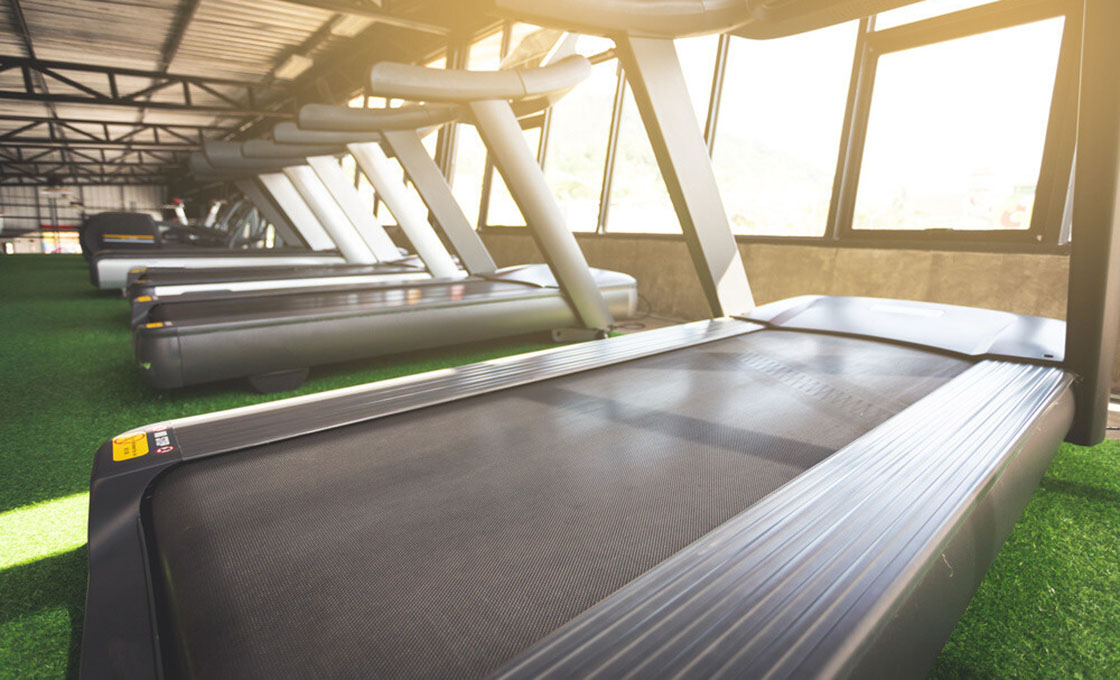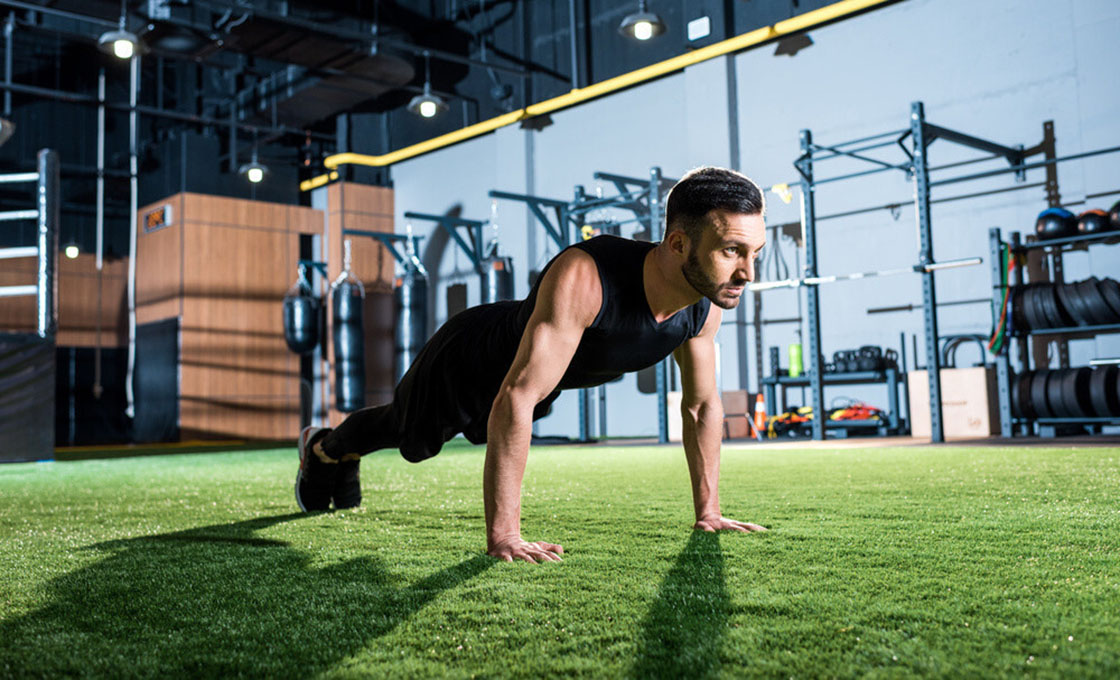Sport Turf For Gyms
Artificial grass is an ideal way to introduce the organic oasis of an outdoor training area into an enclosed environment. With a lush look and feel which is both authentic and affordable, it will freshen up your fitness space with a feature that is clean, contemporary, and comfortable.
Gym artificial grass can be customized to a virtually infinite variety of individual needs. Shape, size, color, thickness, and inlaying can be tailored to suit every space and floor surface, from pets to putting. Turf can be easily secured together in a way that is invisible to the naked eye – plus, it can be removed or replaced quickly when required with minimal mess.
Furthermore, synthetic grass also replicates a real outdoor training environment by providing superior noise and shock insulation, as well as that much-needed traction for a training surface – catering for greater choice in terms of the types of training and equipment which is suitable for use. This allows for adaptability to a much wider array of athletic activities for people at all levels of fitness.
Attractive and adaptable with an authentic appearance: artificial grass is a safe, sleek, and steadfast way to glamourise your gym!

Best Artificial Grass for Gym Flooring Surfaces
Artificial grass for gyms is crafted from waterproof, man-made materials, synthetic turf offers many advantages over natural grass. Adjustable padding options equip artificial grass with an extra layer of safety, offering provision for shock absorption and a steady, anti-slip surface for even higher intensity training. Furthermore, a lack of exposure to natural weather elements paired with the selection of sturdy plastic-based substances used to manufacture synthetic turf fortifies it with superior strength, making it durable enough to last the distance even under the most relentless and regular usage.
Moreover, unlike the fragile foliage of real grass, the blades of artificial turf cannot die or be permanently dislodged by dragging movement, nor can they be easily damaged or distorted. It is also far easier to keep clean, usually requiring little more than a brush-up or mop down, and it is almost impervious to bacteria and parasitic activity – making any area carpeted with synthetic grass one which is hygienic and almost hassle-free to maintain.
As well as boasting many benefits over natural grass, synthetic grass also pips rubber flooring to the post in several important areas. The cleverly designed combination of both padding and plush grass offers a considerably elevated level of comfort and cushioning for athletes and fitness fans who use it.
With its plush volume and vivid hues, artificial grass also adds greater visual appeal than rubber flooring, and generates a feeling of natural freshness in a gym space – cutting through the cold starkness of modern machinery and monotone décor to breathe life into leisure time.
What is Artificial Gym Grass?

Artificial gym grass is a synthetic turfing material used as an alternative to natural grass and rubber flooring for exercise and athletic spaces, such as gymnasiums and sports courts.
With the growth in the variety and intensity of fitness pursuits, artificial grass has become an increasingly popular choice to carpet areas hosting high-traffic activity, due to the number of advantages it offers over the alternatives.
Why Choose Artificial Grass?

Over the last few decades, the gym industry has witnessed a vast increase in interest from a variety of people from all walks of life. Fitness is now viewed by many as a key component for optimal health and a valued social outlet, significantly expanding and diversifying the landscape of the leisure sector.
With more and more people choosing the convenience and comfort of indoor active pursuits, the fitness industry has adapted to the changing needs and desires of their health-conscious members by creating exercise spaces that merge the best benefits of outdoor and indoor areas as much as possible in terms of comfort, convenience, and choice – including for training surfaces.
As natural grass cannot thrive under artificial gym lighting and requires lots of upkeep, the most practical choices for carpeting exercise spaces are artificial turf and rubber-based tiling. Artificial grass offers several key overall advantages for fitness areas over natural grass and rubber flooring:
Advantages over Natural Grass

Safety
When used in indoor gyms, synthetic turfing will never become slippery due to wet weather conditions, nor will it become hazardous to health due to trash or waste.
Also, because it is man-made, it is non-abrasive and can be adapted with a padded under-layer to support shock absorption, which is highly beneficial for those participating in higher intensity physical pursuits as well as those with joint, bone, and muscular issues.
Adaptability
Artificial grass comes in a range of materials, styles, lengths, and colors, and can also be custom cut to fit any size or shape floor surface – making it suitable for use in almost any indoor activity space. Moreover, as it is manufactured in a similar form to carpet, both laying and removing it is a comparatively simple and cost-effective process.
Resilience
Due to being synthetic, artificial grass is much better adapted to withstand the wear and tear of heavy usage from running, jumping, twisting, pulling, and the weight of exercise equipment without its shape and volume being affected so easily by tears, patching, and other damage. Also, as and when any parts do need replacing, this can be done on a piece-by-piece basis in a cleaner, more convenient way than with natural grass.
Minimal Maintenance
Synthetic grass is not living – therefore it does not require a steady supply of sunlight or water. There is also no need for cutting or trimming, nor is there a danger of it dying or wilting. As it is artificial (and often also coated with a bacteria-resistant coating) there is also almost zero chance of synthetic turf becoming subject to problematic fungi or insect activity. Crafted from tough, plastic-based materials, artificial grass is also much easier to keep clean and hygienic than real grass.
Advantages over Rubber Flooring
Mimics a Natural Environment
Similar to rubber flooring, artificial turf flooring can be adapted to absorb shock and noise well in enclosed fitness settings. However, synthetic grass also boasts the added benefits of simulating the plus points of a traditional open-air training surface without the high maintenance as well as adding traction to higher intensity and resistance exercise, such as running.
Comfortable
Made from plush synthetic fiber, artificial grass provides a superior level of padding to flat rubber flooring, enabling extra protection and support for those using it, and an ability to accommodate a wide array of fitness equipment without marking or damage – and also feels soft and supple even for sensitive bare feet.
Attractive
Replicating the look and feel of a natural outdoor feature, artificial grass offers a more organic atmosphere to an activity space and being more aesthetically pleasing to those engaged in regular exercise – particularly as it can be enjoyed without the concern of less chaotic weather conditions.
Types of Artificial Grass
Artificial grass is made from three main plastic-based substances, each with its pros and cons:
Polypropylene
Polypropylene turfing products are the most affordable synthetic grassing option. Fine in structure and soft to the touch, artificial grass crafted from polypropylene is best suited to lighter usage in areas able to maintain a consistent, moderate temperature, such as indoor putting greens or decorative features.
The delicate texture of polypropylene makes it unsuitable for use in gymnasiums due to its limited ability to handle heavy, regular use.
Polyethylene
Polyethylene is a mid-level synthetic grassing option. A popular choice for a variety of artificial turfing projects from landscaping to leisure, these products are the most similar in appearance to real grass and strike a good balance between durability and a natural feel.
As polyethylene is also non-porous it also does not retain odor or bacteria. Coming in a range of colors and densities requires minimal maintenance once laid. Its range of qualities makes it a good option for flooring in gymnasiums, especially when combined with a nylon secondary thatch for extra resilience.
Nylon
At the higher end of the price, spectrum is artificial grass products crafted from nylon. Nylon turf is an incredibly tough substance that can withstand even the heaviest wear and tear and polarised temperature fluctuations and still maintain its shape without flattening, kinking, or fiber loss. Its sturdy construction makes it well suited for a variety of high traffic athletic and sporting areas, including gyms.
However: durability comes at a cost to comfort. Nylon does not have the natural feel or look that polyethylene does, nor does it offer the same level of spongy comfort to users. Due to this, Nylon is often merged with other grassing materials to provide extra reinforcement and life expectancy, blending the best qualities of both.
Advantages of Relyir Artificial Grass
Relyir supply a selection of plush, yet price-friendly synthetic grass products to suit all fitness and sporting needs. Their realistic and resilient turf range includes Stadium, Arena, Elite, and GT product lines, crafted from quality, comfortable materials. Relyir’s artificial grass is also easy to maintain, and available in an impressive choice of customized sizes, cushioning, colors, drainage, and density options.
